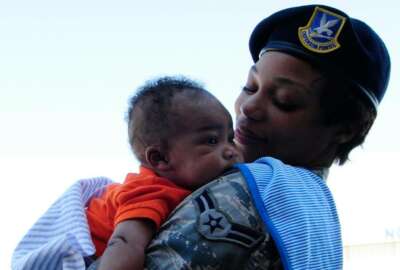

The Air Force says it increased its childcare staffing levels from 65% to 80% in just one year, mainly through incentives other than pay raises.
The Air Force has made some significant progress in addressing its shortage of child care providers in just the past year. Amid a nationwide shortage, the service still has a vacancy rate of 20 percent. But that’s compared to 35 percent in the summer of 2022.
Officials think the improvement is largely due to new incentives that helped attract child care workers to the Air Force’s child development centers. In light of the fact that provider shortages have reached crisis levels in the private sector too, they determined higher pay alone wasn’t going to solve the problem, said Alex Wagner, the assistant secretary of the Air Force for manpower and reserve affairs.
“In June of 2022 when I was sworn in, I said, alright give me a list of every single department of Air Force installation and what we pay on post compared to what we pay in the local community for the average starting wage,” he said at the Air Force Association’s recent annual conference in National Harbor, Md. “It shocked me: in nearly every single case, we were already paying more, and, in some cases, substantially more … but if it takes you two or three months to get on board and pass your security clearance, then all of a sudden that pay differential of one or two dollars more an hour doesn’t really pan out.”
Instead, officials determined funding could be put to better use by offering something child care providers value more than a small wage increase: free and heavily discounted care for their own children. And new direct-hire authorities helped streamline the onboarding process.
Defense Secretary Lloyd Austin had already told the military services to offer 50% discounts to caregivers, but the Air Force wanted to try going further than that: completely free care for every caregiver’s first child, and 25% discounts for each additional child. It worked, Wagner said.
“We’re not at 80% staffing in every location, but I’m looking at the trends every single month, and we’re making progress, he said. “Our CDCs are the gold standard. Everyone wants in, but not everyone is available to meet the CDCs during their opening times. So we are incentivizing a whole host of other options, including family childcare homes, including fee assistance, and we’re focused on that to fill those gaps.”
Each of the military services has proposed significant increases in their child care spending for 2024, but the Air Force’s proposal is the largest: a 19.4% increase over what Congress approved in 2023, for a total of $466 million. According to the Congressional Research Service, across the broader Defense Department, the Pentagon requested a 10.3% increase to $1.79 billion care for the roughly 160,000 6-week to 5-year-olds who currently are cared for in military CDCs.
Dr. Ravi Chaudhary, the assistant secretary of the Air Force for energy, installations, and environment said apart from the increased spending on child care programs, the service is putting more money toward constructing child care facilities.
“We’re making the largest investment in CDCs in over a decade — 19 CDCs are in the works to be built as part of a larger $1.6 billion package that also includes first-term airman dorms,” he said. “Across our offices, we recognize that investments have to be made. That also includes the first net-zero CDC, which honestly means a lot because we’re modernizing in a way that’s going to make us more cost effective in the future.”
Assessing the total scale of DoD’s shortages — both in facilities and in providers — is effectively impossible, because the department doesn’t publish regular data on the topic. Nor does it post base-level information on how long waitlists are at CDCs, an ongoing source of frustration for military parents seeking care. In 2021, Federal News Network obtained a report that showed the Air Force alone had 5,116 children with an “unmet need” for care, and the average waiting time at that point was 151 days. At some bases, it was nearly a year.
Congress is looking to nudge the department in the direction of more transparency, however. A provision in the House-passed 2024 Defense appropriations bill would order the department to deliver a comprehensive report on its current capacity at CDCs, its staffing challenges, and its plans to reduce waitlists.
A separate provision in the House’s 2024 Defense authorization bill would require DoD to create a website that shows waiting lists at each CDC. That legislation suggests Defense officials look at expanding the Air Force’s existing Air Force Child and Youth Programs Business Management System to the rest of the military services.
According to the Air Force, that system was deployed across the service in December of 2022, and acts as a single repository for billing information, immunization, and staffing and enrollment numbers at each CDC. Officials say it eliminated the need to keep track of paper records and process payments manually every month.
“The system captures important data analytics previously only obtainable from time-consuming data calls and sifting through numerous Excel spreadsheets,” Patti Mehrens, an Air Force child development specialist said in an Air Force release announcing the program’s deployment late last year. “The data is now at the tip of our fingers.”
There’s an optical illusion at bottom of the sea.
Source: realclearscience
Copyright © 2025 Federal News Network. All rights reserved. This website is not intended for users located within the European Economic Area.
Jared Serbu is deputy editor of Federal News Network and reports on the Defense Department’s contracting, legislative, workforce and IT issues.
Follow @jserbuWFED

